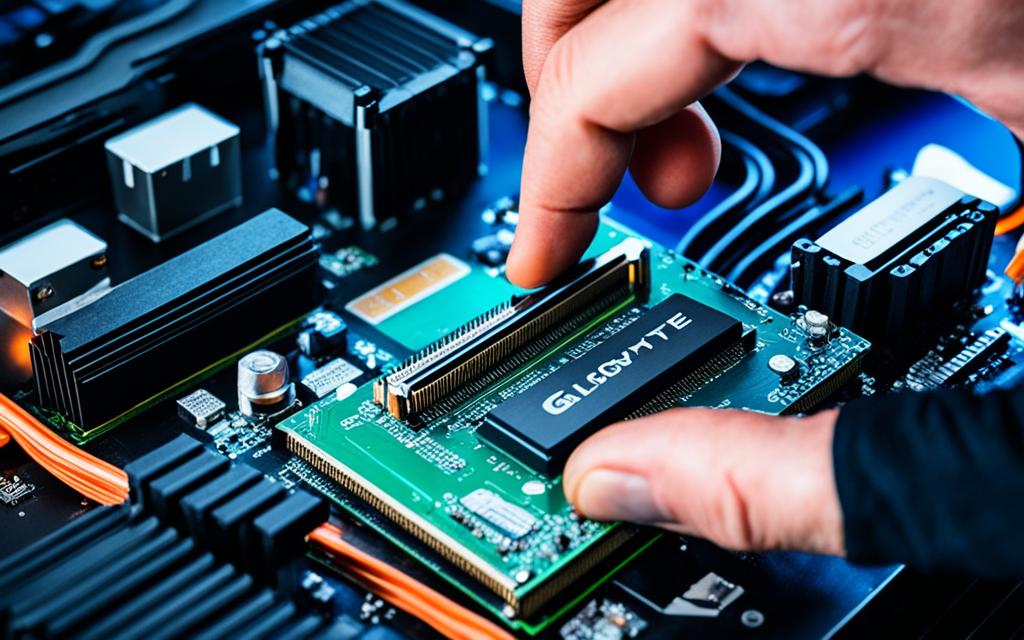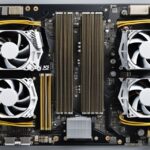Table of Contents
Undervolting your CPU with Gigabyte BIOS makes your computer run cooler and more efficiently. By cutting down the voltage to your CPU, you’ll see less heat and better performance. Our guide will show you how to do this safely, keeping your system stable. It’s great for both experts and new users. To learn more, check out this link on how to undervolt your CPU in Gigabyte1.
Key Takeaways
- Undervolting boosts CPU efficiency and cuts down on heat.
- Good BIOS management means your system runs better for longer.
- Adjusting your voltage can make your CPU last longer.
- Undervolting helps save on electricity bills by using less power.
- With undervolting, you can achieve higher overclocks without hitting thermal limits.
Understanding Undervolting and Its Benefits
Undervolting is a cool way to make your CPU work better and save energy. By reducing the voltage, it uses less power and doesn’t get as hot. This smart move goes against the old idea that more voltage means better performance. Too much voltage can actually harm your CPU over time.
What is Undervolting?
Undervolting means giving your CPU less power. This cuts down on how much electricity it uses and how hot it gets. Keeping your CPU cooler helps it last longer. It also means it can work harder for longer without getting too hot23.
The Importance of CPU Efficiency
For tasks like gaming or video editing, having an efficient CPU is key. Undervolting helps lower your power bills and keeps your system cooler. A cooler system can do more without overheating3. It means your hardware wears out less quickly, making everything last longer2.
Improving Lifespan and Performance
Undervolting is great for keeping your CPU cooler and running smoothly. Reducing voltage carefully means your parts won’t wear out as fast. Cooler systems are also faster because they don’t have to slow down when it gets hot24. After making any changes, be sure to check your system to avoid it crashing too much3.
| Benefit | Impact on Efficiency | Effect on Lifanspan |
|---|---|---|
| Reduced Power Consumption | Lower energy costs | Decreased thermal stress |
| Lower Heat Generation | Improved stability | Extended operational lifespan |
| Enhanced Performance | Higher sustained clock speeds | Less frequent throttling |
Using undervolting can make your CPU better while saving energy and staying cooler2.
How to Access Your BIOS
Getting into the BIOS on your Gigabyte motherboard is key for optimising your system. Knowing how to enter and use the BIOS interface helps in tweaking settings. This ensures your computer runs smoothly.
Key Combinations for Gigabyte Motherboards
To enter the BIOS on Gigabyte motherboards, you’ll need to know the right key combination. This varies by motherboard model. The most common keys are:
- F2
- F10
- Delete
Hit the right key right as your computer starts, but before it loads Windows. Getting the timing right is crucial for getting into the BIOS.
The BIOS is full of tabs and options that might seem daunting at first. Learning to navigate it is crucial for finding the settings you need quickly. Look for CPU voltage and other adjustments under tabs called ‘Advanced’ or ‘Tweaker’.
Different models have their layouts which affects how to change settings. Knowing your BIOS version makes adjusting settings faster. This helps manage your CPU better for the best system performance.
How to Undervolt Your CPU in Gigabyte BIOS
Undervolting boosts your CPU’s efficiency and performance. It’s crucial to adjust the CPU voltage in Gigabyte BIOS carefully. Doing so balances power use and keeps your computer cool. Here, we outline how to modify CPU voltage and keep your system running smoothly.
Steps to Adjust CPU Voltage
To start, reboot your system and enter the BIOS menu. Look for CPU settings, often called ‘Core Voltage’ or ‘Vcore’. Begin by slightly lowering the voltage, either by 0.05V or 0.1V. Aim for the best performance without causing instability.
Lowering the vcore slightly has benefits. For example, it improved R9 3900X processors’ performance by 2% on some motherboards5. Your system might also run cooler and perform better in stress tests6.
Testing Stability After Adjustments
Once you’ve adjusted the CPU voltage, test the stability. Use HWMonitor to check temperatures and stress-testing tools to measure performance. It’s essential to monitor these factors to detect any instability. If you find instability, go back to the last stable settings to protect your computer.
Sometimes, setting the vcore too low may decrease performance, even if it looks stable5. Remember, even small changes can lead to great improvements if done properly.
Testing revealed that behaviour varied depending on CPU and motherboard configurations, highlighting the importance of careful experimentation for optimal results.
Monitoring Your CPU’s Performance
To get the best out of your CPU, keeping an eye on its temperature is key. Checking it often with trustworthy software helps stop overheating. This keeps your system running well when doing heavy tasks.
Using HWMonitor for Temperature Checks
HWMonitor lets you watch your CPU’s temperature, voltage, and stability. It gives real-time data on how hot your CPU gets when idle or under stress. This is crucial for adjusting voltages wisely, especially after lowering them to avoid overheating. A lot of people are into this, with a discussion hitting 22,000 views, showing high interest7.
Understanding Ideal Temperature Ranges
It’s vital to keep your CPU at the right temperature for its health and performance. CPUs work best between 30-70°C when being used a lot. If it gets hotter than this, it can slow down, affecting how well it works. Some have even got their CPUs cooler, to 23-28°C, by tweaking their BIOS settings7.
Although small performance drops can happen after adjustments, controlling the temperature well adds a lot to the system’s stability and life7.
| Temperature Range (°C) | Performance Level | Risk Level |
|---|---|---|
| 30-50 | Optimal | Low |
| 51-70 | Normal | Moderate |
| 71-90 | High | High |
| 91+ | Critical | Risk of Damage |
Watching your CPU’s temperatures is key to boosting your computer’s performance and avoiding heat problems. With the proper tools and knowledge, you can keep your CPU at ideal temperatures easily7.
Conclusion
Undervolting your CPU in Gigabyte BIOS is a smart move for those wanting to boost CPU performance and save power. It involves lowering voltage levels but keeping them stable. This reduces power use and heat, leading to a more efficient computer.
This method boosts system performance and increases hardware life—key for PC lovers. It helps your computer respond better, especially when you need lots of power for gaming or making content. Adjusting CPU settings opens up new ways to experience computing, with cooler and quieter systems.
By following the given steps and using monitoring tools, users can refine their computers. They’ll see real improvements in performance and efficiency. Embracing undervolting helps find a perfect balance, a vital skill for newbies and pros alike89.
FAQ
What is undervolting and how does it benefit my CPU?
Undervolting is when you reduce the voltage to your CPU. This can make your CPU more efficient by lowering its power use and heat production. This results in better performance, helps with cooling, and makes your CPU last longer.
Can undervolting improve gaming performance?
Yes, undervolting can boost your gaming experience. It stops your CPU from getting too hot during heavy gaming. This means your CPU performs well under pressure, leading to smoother games.
How do I access the BIOS on my Gigabyte motherboard?
To get into the BIOS on a Gigabyte motherboard, press keys like F2, F10, or Delete as your computer starts, before the operating system kicks in.
What settings should I look for when undervolting?
Look for CPU settings in the BIOS, such as Core Voltage or Vcore. Lower the voltage carefully, in small steps like 0.05V or 0.1V, to keep your system stable.
How can I monitor my CPU’s performance after undervolting?
Use HWMonitor to check on your CPU’s performance. It lets you track temperatures, voltages, and stability when you push your system after adjusting the voltage.
What are the ideal temperature ranges for my CPU?
Your CPU should usually work within 30-70°C under load, according to its maker’s guidelines. Staying within these temperatures helps prevent overheating and damage.
Is undervolting safe for my CPU?
Undervolting is safe if you do it slowly and carefully. Always test how stable your CPU is after each adjustment. Keep an eye on temperatures to dodge any damage.
Source Links
- https://www.overclock.net/threads/undervolting-13700k-on-gigabyte-z690-ddr5.1805880/ – Undervolting 13700K on Gigabyte Z690 DDR5
- https://ms.codes/blogs/computer-hardware/how-to-undervolt-cpu-gigabyte-bios – How To Undervolt CPU Gigabyte Bios
- https://www.digitaltrends.com/computing/how-to-undervolt-cpu-guide/ – How to undervolt a CPU: Complete guide to undervolting | Digital Trends
- https://genexisx.blogspot.com/2019/09/laptop-undervolting-guide-intelnvidia.html – [GUIDE] How to undervolt laptop (Intel CPU and Nvidia GPU, 2021 revised version)
- http://gamersnexus.net/guides/3494-amd-ryzen-3000-undervolting-offset-override – AMD Ryzen 3000 Undervolting Offset vs. Override | Vcore Voltage | GamersNexus
- https://www.gigabyte.com/FileUpload/Global/multimedia/2/file/548/988.pdf – PowerPoint 簡報
- https://www.overclock.net/threads/13900kf-on-gigabyte-aorus-master-z790-how-to-decrease-temperature-a-2-month-story-short.1804651/ – 13900KF on Gigabyte Aorus Master Z790 – how to decrease…
- https://www.reddit.com/r/GamingLaptops/comments/s2n9kq/gigabyte_g5_kc_8_months_later_undervolting/ – Reddit – Dive into anything
- https://www.auslogics.com/en/articles/what-is-undervolting-a-cpu-explained-in-detail/ – What Is Undervolting a CPU? Explained in Detail








